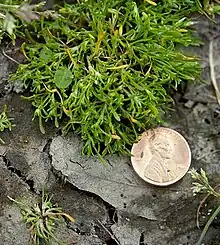| Montia howellii | |
|---|---|
 | |
| Scientific classification | |
| Kingdom: | Plantae |
| Clade: | Tracheophytes |
| Clade: | Angiosperms |
| Clade: | Eudicots |
| Order: | Caryophyllales |
| Family: | Montiaceae |
| Genus: | Montia |
| Species: | M. howellii |
| Binomial name | |
| Montia howellii | |
| Synonyms[2] | |
| |
Montia howellii is a species of flowering plant in the family Montiaceae known by the common names Howell's miner's lettuce and Howell's montia. It is native to western North America from British Columbia to northern California, where it grows in moist to wet habitat, including vernal pools and meadows. It sometimes grows in shallow standing water such as puddles. The species is known from fossilized seeds recovered from sediments of the Pleistocene Tomales Formation and from a small paleoflora at San Bruno.[3][4] Further, Daniel Axelrod discussed Montia howellii as one of the biogeographically significant species comprising the Millerton Palaeoflora at Tomales.[5]
Description
It is a small, low, mat-forming annual herb growing up to about 9 centimeters in maximum length. The linear or lance-shaped, sometimes grasslike, leaves are alternately arranged and measure up to 2.5 centimeters in length. The inflorescence bears 2 to 6 minute flowers with oval green sepals no more than 2 millimeters long and white petals less than a millimeter in length. The flower is usually cleistogamous, self-fertilizing and sometimes never even opening.
Conservation
This species is believed to be in decline in California, and is ranked as "vulnerable" to extinction overall by NatureServe.[1] Threats to the species include grazing, farming and urbanization.[1]
References
- 1 2 3 NatureServe (3 March 2023). "Montia howelli". NatureServe Network Biodiversity Location Data accessed through NatureServe Explorer. Arlington, Virginia: NatureServe. Retrieved 4 April 2023.
- ↑ The Plant List: A Working List of All Plant Species, retrieved 8 May 2016
- ↑ Mason, Herbert L. 1932. Pleistocene Flora from San Bruno. Carnegie Institute of Washington Publication No. 415, pages 25-44
- ↑ Mason, Herbert L. 1934. Pleistocene Flora from the Tomales Formation. Carnegie Institute of Washington Publication No. 415, pages 81-179.
- ↑ Axelrod, D. I. 1983. New Pleistocene Conifer Records, Coastal California. University of California Publications Geological Sciences Volume 127. Berkeley: University of California Press, 31 pp ISBN 0-520-09707-6
External links
